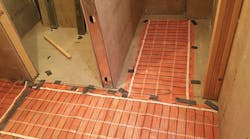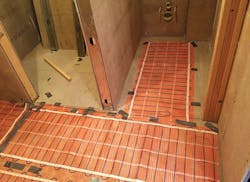All references are based on the 2014 edition of the NEC.
Many of you have probably experienced the unpleasant feeling of stepping out of a nice hot shower on a freezing cold winter day only to step on an icy cold tile floor. What could be worse than that feeling? Well, stepping out onto that tile floor and getting electrocuted by some faulty electric floor heating cables would certainly be worse.
Fortunately, Sec. 424.44(G) lists requirements for these cables, which should hopefully minimize the likelihood of that type of event from ever happening. Nevertheless, that Code section also has some loopholes. According to Sec. 424.44(G), electric heating cables installed in the floors of bathrooms, kitchens, and hydromassage bathtub locations must be provided with GFCI protection for personnel. This protection should help minimize the possibility of a deadly shock from happening while you are standing on that conductive floor — possibly while you are soaking wet. However, there are some other areas that may pose the same type of hazard, but are literally not required by the Code to have the same GFCI protection.
For example, a room with a shower stall or bathtub but no sink is not a bathroom per the definition in Art. 100. There are many homes where this type of floorplan exists. Electric heating cables installed in the floors of rooms with only a shower stall or a bathtub do not require GFCI protection per Sec. 424.44(G), because those rooms are not bathrooms by definition.
Is it the intent of the Code to specifically exclude those areas from the GFCI rules? I doubt it. In fact, the manufacturer’s product instructions may still require the GFCI protection for those areas, and, according to Sec. 110.3(B), equipment must be installed in accordance with any instructions that are part of the listing or labeling.
It can certainly be confusing when trying to follow Code requirements. Of course, whenever you have any doubts or questions about what the Code is trying to say, it’s always best to have a civil and professional discussion with the authority having jurisdiction (AHJ). After all, it is his or her job to interpret the Code.
If you were the person on that cold winter day who was stepping out of that hot shower onto that tile floor, would you want those heating cables beneath your soaking wet feet to have GFCI protection? I know I would, and I think most of you would probably agree with me.





